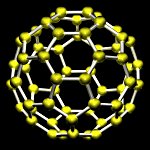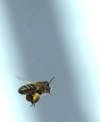 Most people are well aware of the traditional materials offered to married couples to celebrate their wedding anniversary. You know the kinds of thing I mean – ruby for instance is the gem of choice for a 40th anniversary, although why a chunk of chromium infested aluminium oxide should have been chosen for this year in particular I don’t know. The noble elements silver and gold are 25th and 50th respectively, while the hardest allotrope of carbon, represents the 60th celebration (diamond, that is). If you want the complete list check out our traditional wedding anniversary gifts page, but if you want something a little different, a reference for Kevlar, zeolites, buckyballs, or PVC say, take a look at our chymical wedding round-up.
Most people are well aware of the traditional materials offered to married couples to celebrate their wedding anniversary. You know the kinds of thing I mean – ruby for instance is the gem of choice for a 40th anniversary, although why a chunk of chromium infested aluminium oxide should have been chosen for this year in particular I don’t know. The noble elements silver and gold are 25th and 50th respectively, while the hardest allotrope of carbon, represents the 60th celebration (diamond, that is). If you want the complete list check out our traditional wedding anniversary gifts page, but if you want something a little different, a reference for Kevlar, zeolites, buckyballs, or PVC say, take a look at our chymical wedding round-up.
Category: Chemistry
As long-time readers will know, Sciencebase has its roots in the first chemistry webzine, Elemental Discoveries, started by David Bradley Science Writer back in December 1995. The site continues to provide chemistry news from around the world.
Check out the Sciencebase Twitter and Facebook pages for even more.
Acid test research project
This probably is not a project you could do for your school science project, unless you are really, really keen. Chemists at Queen’s University Belfast have developed a molecular system that acts like an ion-selective electrode across a pH range of 9. Prasanna de Silva and his colleagues, who featured in a special issue of Intute Spotlight recently, explain that their device has the advantage of operating on the nanoscale and so could be incorporated into microelectromechanical systems, or so-called lab-on-a-chip devices. The team used a set of four sensor molecules in relay to act as the quantitative version of universal indicator paper. One sensor does the hard work of sensitively responding to pH across approximately 2 pH units and then hands on the baton to the next, which in turn works hard over the next 2 pH units and so on covering 9.5 units on the pH scale. de Silva says that the molecular devices show an almost linear intensity-pH profile that is reminiscent of the response of a conventional glass pH electrode but a thousand times smaller than even micrometer-scale intracellular pH electrodes.
“Our research shows a simple and predictive way of greatly extending the sensing range of molecular sensors,” de Silva told Sciencebase, “We do it by using a set of four sensors to act somewhat like a 4×100 m relay team. One sensor does the hard work of sensitively responding to pH across approximately 2 pH units and then hands over the task to the next one, which in turn works hard over the next 2 pH units (approximately) and then hands over the task to the next one etc. In this way we get a range of 9.5 pH units whereas the normal range of a molecular sensors is only 2 (as you learn in high school science).”
Scientists have thought about this problem before (resulting in the famous universal indicator), there was no quantitative version of a molecular universal indicator until now. The nearly linear intensity-pH profile is reminiscent of the glass pH electrode’s response, even though the electrode is obviously a lot bigger in size (the smallest ones are micrometer-sized and used for intracellular pH measurements), de Silva told me.
You can get the full experimental details in their JACS paper on this: Analog Parallel Processing of Molecular Sensory Information
A semantic chemist – fixed
 I recently interviewed Robert Parker, the new Managing Director of RSC Publishing, you can read his interview in the February issue of chemistry news magazine Reactive Reports in which he discusses a new approach to the publication of scientific papers, RSC Prospect, and how it will benefit readers and the scientific community at large. It would be interesting to know what users think to the RSC’s new approach to meta data and a semantic chemical web.
I recently interviewed Robert Parker, the new Managing Director of RSC Publishing, you can read his interview in the February issue of chemistry news magazine Reactive Reports in which he discusses a new approach to the publication of scientific papers, RSC Prospect, and how it will benefit readers and the scientific community at large. It would be interesting to know what users think to the RSC’s new approach to meta data and a semantic chemical web.
“We needed a meaningful way of identifying compounds uniquely and one that’s machine readable – InChI fits the bill. Similarly, CML offers us a way of structuring lots of the science within a paper to both preserve the original science and do interesting things with it, and by demonstrating some of these applications, we hope to encourage wider adoption,” Parker told me, among other things. Check out the interview for his take on Web 2.0 for chemists, blogs and wikis, and more.
Also, featuring in Issue 62 of Reactive Reports:
 Take the Volcanic Fast-track to Nanotube Production Igneous rock from the Mount Etna
Take the Volcanic Fast-track to Nanotube Production Igneous rock from the Mount Etna
volcanic eruptions could be used to mass produce carbon nanotubes, according to researchers in Germany. Alumination at last! More powerful solid rocket fuel could be the product of research into a new
Alumination at last! More powerful solid rocket fuel could be the product of research into a new
class of compounds containing aluminum and hydrogen compounds, according to an international research team. How Wine Producers Might Save Asthma Sufferers from Sulfites Ozone could replace sulfites
How Wine Producers Might Save Asthma Sufferers from Sulfites Ozone could replace sulfites
as the preservative of choice in a new asthma-friendly approach to wine production.
New radiation warning sign
 The sixtieth issue of the “new” Alchemist is now online over on Sciencebase partner site ChemWeb.com. As you might expect having reached this tender age, we’ve put on a little weight, as of this issue there will be more chemistry matters.
The sixtieth issue of the “new” Alchemist is now online over on Sciencebase partner site ChemWeb.com. As you might expect having reached this tender age, we’ve put on a little weight, as of this issue there will be more chemistry matters.
In this week’s issue, new symbolism in the world of ionizing radiation, a rubber band theory that requires no stretch of the imagination to work, and an atomic approach to murder. Also in this week’s issue, new catalysts could make use of wasted natural gas that is simply vented and flared at oil wells and archaeological evidence that Christopher Columbus’ fellow travelers struggled to find enough silver. Finally, crumpling hydrogels could give chemists a taste for plastic origami. Also in this issue our new awards/announcements section – this week fueling fuel cell research to the tune of $1.5million.
Check out the ChemWeb Alchemist every fortnight.
Chemistry aside though, what do Sciencebase readers think of the new radiation sign the IAEA wants to make standard? To me it looks far more cluttered and confusing than the original trefoil. the IAEA says that lots of people don’t know what the trefoil represents, but surely if you come across a huge lead box with a big red triangle on it and a symbol that looks like something out of a science fiction movie you’re not going to break it open to see what’s inside…or maybe some people would. The IAEA says there are too many needless deaths and serious injuries from accidental exposure to large radioactive sources and that tests have shown that the meaning of this new symbol for category 1, 2, and 3 radiation sources is far more obvious than the old trefoil. It will mean a whole new redesign for those movie sets though.
Shadowy face recognition
 Face recognition is the most obvious approach to identification but it suffers from a major drawback – shadows and bad lighting. If there is inconsistent lighting in a room or on a face then it becomes difficult to produce reproducible digital image of the face for face recognition algorithms to work with. Now, researchers in China have turned to near infra-red to help computers cope with variable lighting conditions and so recognize even the most shadowy of faces.
Face recognition is the most obvious approach to identification but it suffers from a major drawback – shadows and bad lighting. If there is inconsistent lighting in a room or on a face then it becomes difficult to produce reproducible digital image of the face for face recognition algorithms to work with. Now, researchers in China have turned to near infra-red to help computers cope with variable lighting conditions and so recognize even the most shadowy of faces.
Face recognition is a key function of the human brain…let me put it another way, from a very, very early age we can all recognize faces, from the familiar view from mother’s knee to spotting a friend in a crowd. Computers too can process a digital image and compare it with a database entry to carry out simple face recognition. But only if the light is right. Throw in a few shadows, sunlight through a window, or a flickering overhead fluorescent light, and the computer usually cannot spot the difference between John Doe and Joe Bloggs. Stan Li believes the answer lies in the near infra red, you can find out more tomorrow in the latest issue of spectroscopynow.com or get an advance view here.
Antioxidant buzz
 Bees making honey from honeydew rather than nectar produce a sweet material that has greater anti oxidant properties than nectar honey, according to a study of 36 honey samples from Spain with different floral origins. The study published this month in the Journal of the Science of Food and Agriculture could point to a way to improve the health benefits of this natural sweetener.
Bees making honey from honeydew rather than nectar produce a sweet material that has greater anti oxidant properties than nectar honey, according to a study of 36 honey samples from Spain with different floral origins. The study published this month in the Journal of the Science of Food and Agriculture could point to a way to improve the health benefits of this natural sweetener.
The composition of honey depends greatly on where honeybees collect their raw materials. There are two key sources. Honeybees can collect nectar from flowers, and this generates nectar honeys or they can collect fluids exuded by plants, honeydew.
‘Honey is a natural source of antioxidants, and among honeys, honeydew honey is the best,’ says researcher Rosa Ana Pérez, who works at the Instituto Madrileño de Investigación y Desarrollo Rural, Agrario y Alimentario, in Madrid, Spain.
Each of the 36 honeys was exposed to a range of physical and chemical tests. Honeys with high antioxidant properties also had high total polyphenol content, net absorbance, pH and electrical conductivity.
‘These laboratory results show some aspects that people could use to get an idea about which honeys are likely to have the most potent antioxidant properties,’ says Pérez.
Oxidation is a chemical process in which electrons are transferred from from one substance to an oxidizing agent. Antioxidants are basically compounds that slow the rate of oxidation and are as important the chemistry laboratory as they are in the human body. Antioxidants work either by reacting with intermediates and inhibiting the oxidation reaction directly, or themselves reacting with the oxidizing agent and acting as a molecular decoy to prevent the oxidation reaction from occurring.
All living things try to sustain a reducing (the opposite of oxidizing) environment within their cells to prevent damage by oxidation of their biomolecules. Compounds such as glutathione and ascorbic acid (vitamin C) as well as enzymes (peroxidases and oxidoreductases) act as antioxidants. If you do not have adequate levels of antioxidants in your body then oxidative stress and cell damage can occur. More controversial is the notion that supplementing with antioxidants a balanced diet of fruit and vegetables has any additional benefits, claims of anticancer effects and reduced risk of cardiovascular disease have yet to be proved. Indeed, excess of certain antioxidants can do more harm than good.
Does Traditional Chinese Medicine work
 Many of the health claims of herbal medicine bear fruit for the pharmaceutical industry, leading to new drugs that are more potent and more targeted than the original remedy. In Traditional Chinese medicine there are many health claims for the likes of Ginkgo biloba and many other remedies that might bear closer scrutiny. Now, pharmaceutical chemist David Barlow and colleagues Peter Hylands and Thomas Ehrman at King’s College London have undertaken the biggest study yet of the active ingredients in TCM and used an analytical system known as a multiple decision tree technique, called Random Forest, to unearth the root of the activity of the natural products in TCM.
Many of the health claims of herbal medicine bear fruit for the pharmaceutical industry, leading to new drugs that are more potent and more targeted than the original remedy. In Traditional Chinese medicine there are many health claims for the likes of Ginkgo biloba and many other remedies that might bear closer scrutiny. Now, pharmaceutical chemist David Barlow and colleagues Peter Hylands and Thomas Ehrman at King’s College London have undertaken the biggest study yet of the active ingredients in TCM and used an analytical system known as a multiple decision tree technique, called Random Forest, to unearth the root of the activity of the natural products in TCM.
Their study seems to vindicate many of the claims of TCM as well revealing several compounds that might be indicated for diseases and symptoms not treated with in the traditional system.
The team built a database containing well over 8000 compounds from 240 of the most commonly used TCM herbs and used a second database of almost 2600 known active plant chemicals and other natural products as a training set for the Random Forest computer algorithm. The team found that about 62% of the herbs they tested in silico against various drug targets (mostly enzymes associated with pathogens or problems in the body) contained candidate drug compounds that might be isolated for treating a single disease without the associated issues of a TCM approach. They also found that more than half of these compounds worked against at least two diseases and so might have multiple applications.
You can read more about this research today on SpectroscopyNOW news round up from David Bradley. I asked Barlow about the wider application of this research and he said it might be applied equally well to other databases. “The same methodology might also be applied in screening other similar databases, constructed, for example, with reference to herbs used in Ayurvedic medicine,” he said.
Identifying the Valentine’s Day murder weapon

The air in the courtroom was so thick you could cut it with a…well…a knife, some broody dame was sobbing in the gallery, and the steno guy snuffled as he bashed the keys. It was a year ago today, Valentine’s Day, that the massacre took place. The investigating team was presenting its evidence, it was obvious to everyone but the judge, who’d stabbed the victim, the knife and the body had both been bagged. Trouble is, there was a thread hanging from the attorney’s Armani, but this was no slapdash haberdashery, this was the proverbial chink in the armour through which a guilty blade could easily slip. The wound was inflicted with the kind of blunt edged kitchen knife you can buy in any five and dime store so it was looking like our felon wasn’t gonna face the chair after all…
But wait, new evidence just in, a study of metal particles found in the valentines day wound reveals the presence of nickel and chromium atoms, exactly the same metallic blend on the accused’s kitchen dagger and in exactly the same ratio as the cutting edge of the knife itself. Crank up the juice Eugene, we got ourselves a fryer!
More cloak and dagger this week in David Bradley takes on Sam Spade, over on SpectroscopyNOW. You do know how to whistle, don’t you?
Intute Spotlight for February
 The latest physical science news from David Bradley can also be found on the intute portal under the Spotlight. This month:
The latest physical science news from David Bradley can also be found on the intute portal under the Spotlight. This month:
Shedding light on a molecular lock
Logic at the molecular scale has been exploited to build a keypad lock that “opens” only when the correct sequence of inputs is applied. Researchers at the Weizmann Institute of Science in Israel explain how they have harnessed the principles of molecular Boolean logic to create a nanoscale keypad lock…one you’re going to need very small fingers to key.
Anthropogenic volcanic activity
The first scientific report into the causes and impact of Lusi, the Indonesian mud volcano located in Eastern Java that erupted on 29th May 2006 in the middle of a rice paddy, has now been published. The results provide a damning indictment of the cause of this eruption, laying the blame most likely at the feet of natural gas explorers.
Demonic chemistry
In 1867, Scottish physicist James Clerk Maxwell devised a thought experiment that would help scientists find ways of breaking the law. The second law of thermodynamics, that is. The second law of thermodynamics tells us that heat cannot pass from a hotter object to a colder one. David Bradley talked to David Leigh who has devised a molecule that almost plays a demonic role.
Read the February issue of Intute Spotlight online now.
NearIR Nightly
Organic light-emitting diodes (OLEDs) are finding applications in a whole range of devices now not least because of their flexibility, in both the physical and viability sense, and their high energy efficiency. Until recently, however, OLED research was focused on visible emission. Now, US scientists have developed a near infra-red OLED, a NIR OLED. They reckon an NIR OLED could be used in future night-vision devices. NIR OLEDs might also one day find use in small-scale, portable NIR spectrometers or lab-on-a-chip systems for medical and environmental analysis, or potentially chemical and bio weapons detection.
Mark Thompson of the University of Southern California and colleagues at Princeton University, Steve Forrest’s group at the University of Michigan, and Julie Brown’s team at Universal Display Corporation have used a phosphorescent platinum-porphyrin complex as a doping agent to create the new class of NIR OLED.
You can read the full story in my SpectroscopyNOW column this week.
If anyone gets the allusion in this post title, drop me a line.